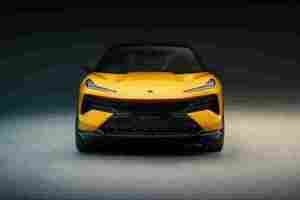Lotus’ Eletre 600hp SUV can ‘breathe’ and put on a light show
British sports car maker Lotus has finally unveiled its long-awaited second electric vehicle, the Eletre.

It’s the company’s first SUV, and while such vehicles don’t usually get called beautiful, this time I’ll call it: the Eletre is a slick-looking machine, which seems like a hell of a package.
Feast your eyes:
As you can see above, the EV isn’t beautiful in a conventional way. Its design language is rather aggressive with a cab-forward stance, long wheelbase, and short overhangs. Its front also looks like an angry reptile of sorts. Still, there’s a distinctive elegance somewhere in there.


Lotus boasts that Eletre shares the same DNA with its Evija electric hypercar. And while it can’t really compare with the Evija, this new EV does come across as a high-performance SUV worthy of the Lotus badge.
Built on a dedicated electric architecture platform, the Eletre comes with two electric motors enabling four-wheel drive. There will be three versions available — the least powerful delivering 600 horsepower.
Lotus claims it will sprint to 62mph in under three seconds and top out at 260km/h.
Powered by a 100kW battery, the Electre’s good for an impressive 600km (373 miles) range on a single charge.
To enable this performance the design team has focused on reducing weight and improving aerodynamics.
The body panels are all made from aluminum, while the black components are finished in carbon fiber.
But the most notable characteristic is Eletre’s “breathing” function.
Much like the Evija, the vents in the Eletre’s hood, lower grille, front fenders, D-pillar, and outer edges of the taillights serve as channels where air can pass through.
Lotus calls this “porosity.” The benefit? Reducing air resistance and, in turn, improving efficiency and range.
Most notably, the front grille comprises interconnected triangular panels, which stay closed when the car is at rest or when it needs to reduce aerodynamic drag. They automatically open to scoop air to the radiator to cool the electric motors, battery pack, or front brakes when needed.
The Eletre’s lights are my favorite part of the car.
The most impressive feature is what the company calls the “peacock moment.”
When the driver unlocks the vehicle, its exterior lights run through a short animated sequence, the front grille opens and “breathes,” and the illuminated flush door handles get deployed.
It’s a pure show-off move, but who doesn’t enjoy a little drama?
In the rear, the full-width ribbon light strip can change between four colors. To give you an idea, it’s red while the car is on the move, and when it’s green, it displays the battery status.
Plus, there’s another color-changing light strip below the instrument panels inside the car. It alerts occupants to incoming phone calls, changes in cabin temperature, or battery charge status.
Interestingly, the Eletre comes with deployable LiDAR sensors, emerging from the top of the windscreen, the top of the rear glass, and the front wheel arches.
That way, the vehicle is future-proofed for advances in autonomous driving tech. Lotus says that extra autonomous functions can be added through OTA updates — as and when it’s allowed.
For now, LiDAR’s being put to good use, enabling ADAS functions like adaptive cruise control, lane-keeping assist, and automated emergency braking.
Similarly, the side mirrors have been replaced by Electric Reverse Mirror Displays (ERMDs), housing three separate cameras — one for the rear-view mirror, one to create a 360-degree view of the SUV, and a third that’s part of the EV’s intelligent driving technologies.
Moving inward, the Eletre will come in both four- and five-seat layouts, situated below a fixed panoramic sunroof.
Its interior looks spacious and features a minimalistic design — just with a dash of luxury.
In the front, the instrument cluster has been reduced to a slim strip for key vehicle and journey information. Information can also be projected onto the windscreen via an AR heads-up display, so the driver doesn’t have to take their gaze off the road.
Both the front and the rear occupants can access OLED infotainment touchscreens, measuring 15 inches and 9 inches, respectively.
All in all, we know quite a lot about the Eletre to be blown away. But… there’s one thing we don’t know: the price. For reference, the Evija comes costs a hefty $2 million.
I’m pretty sure that the Eletre won’t come with such a price tag, but according to Car and Driver , its price is expected to be close to Tesla’s Model X. This indicates a starting point of about $120,000 when the EV reaches the US in 2024.
But as the car will be produced in China by Lotus’ parent company Geely, manufacturing costs should be cheaper, which could — hopefully — bring down consumer pricing as well.
‘Greenhushing’ is the new greenwashing in the EV industry
We’ve been all-in from the get-go. Committed to total transparency about electric vehicles’ climate impact, and our progress towards a sustainable mobility.

When we published our first Polestar 2 Life Cycle Assessment in 2020, including its full methodology, we encouraged other car makers to become more transparent about their products’ climate impact.
Instead, several well-known brands released their own report that attempted to contradict ours. The Astongate scandal, as it became known, now has its own Wikipedia page , where you can read about how their greenwashing campaign quickly fell to pieces.
We recently doubled down on our commitment to transparency by releasing our second LCA report . It reveals the climate impact of the two new Polestar 2 versions.
This time we’re not expecting to see a repeat of Astongate. But we can’t help noticing the silence from the rest of the automotive industry.
First came the greenwashing. Now it’s greenhushing.
Greenhushing, the opposite of Greenwashing
You’re probably familiar with the term greenwashing, which describes a deceptive form of marketing that aims to persuade people that an organization’s products, aims and policies are more environmentally friendly than they really are.
Greenhushing is the term used to describe an organization’s deliberate undercommunication about its sustainability practices, in the hope of avoiding scrutiny and criticism.
When companies shy away from talking about the steps they’re taking in the right direction, the result is that consumers and other stakeholders miss the chance to be informed, educated and inspired about real-world progress.
By trying to avoid being seen as not perfect, they show nothing of value. It’s a lose-lose situation. But there is a simple solution.
Companies must take responsibility
Thomas Ingenlath, Polestar CEO, says:
Both greenwashing and greenhushing destroy people’s trust. And without trust, how can anyone tell whether the ‘sustainable’ product they’re thinking of buying is any more or less sustainable than its competitors?
The answer can only be transparency, because transparency breeds trust.
The journey to sustainability
Of course, we’re not the only brand that’s trying to drive the transition to a sustainable society. More and more companies are taking up the challenge, not only of acting more sustainably, but also talking candidly about their policies, commitments, successes, and failures.
Patagonia is a notable example. Their founder, Yvon Chouinard, takes a refreshingly matter-of-fact approach to sustainability:
Music to our ears. For us, the journey to sustainable mobility is exactly that: a journey. We’ve made a good start, but there’s still a long way to go.


“We are working towards net zero production emissions, but our LCA shows that Polestar 2 is already a climate solution. EV technology provides a car with less than half the carbon impact of an equivalent petrol car if charged with green energy,” says Fredrika Klarén, Head of Sustainability at Polestar.
Transparency helps consumers make informed choices
Our commitment to transparency goes beyond reporting our cars’ carbon footprint. It also covers supply-chain ethics and materials traceability. We’re shining a light on every aspect of our supply and value chain, and documenting our setbacks and challenges, along with our successes.
By telling the whole truth about electric cars’ climate impact, Polestar aims to inspire other carmakers to become more transparent about sustainability.
And by admitting that we’re not perfect, we hope to start winning back people’s trust in the automotive industry as a whole.
Because real change will only happen when consumers start demanding more from companies. And in order to do that, they need to be given the right tools.
No greenwashing. No greenhushing. Just the plain, unvarnished truth.
Polestar and Shift
As we look to the future of personal mobility, sustainability is a critical consideration. That’s why we partnered with The Next Web to bring information about all the exciting changes in the automotive industry together on this page. Accelerating the shift to sustainable mobility by making electric driving a question of when, not if.
Visit the Polestar site to find out more about our approach to sustainability , including details of the four key drivers of sustainable development: climate neutrality, circularity, transparency, and inclusion.
Kawasaki is keeping way too quiet about its 3 electric motorbikes coming in 2022
Kawasaki may not have yet a single electric motorcycle in its lineup but, hey, it did announce last month that it’ll go all-electric for traditional Western markets and Japan by 2035.

And things seems to be going in the right direction already, as the company’s CEO Hiroshi Ito confirmed the launch of three electric motorbikes as early as 2022.
Speaking at the 2021 EICMA Motor Show , Ito said:
And while we held our breath, waiting for him to take the cover off one of the two concealed motorcycles standing behind him — what a glorious unveiling that’d have been — we were faced with disappointment.
There was no electric model under the wraps — not even a concept version.


So we’re stuck with the few details we know from 2019, when Kawasaki showcased an electric prototype through a video release.
The video features an interview with Yoshimoto Matsuda, Kawasaki R&D’s senior manager of the Innovation Department, and here’s a (very) small list of the specs we could gather:
Its exterior is similar to the Ninja 650 model
It features an unspecified powertrain on which the company has been working since the early 2000s
There’s a thumb-activated regenerative braking lever
It has a CHAdeMO charging connector
Yep, that’s pretty much all the information we have for you from that clip.
Kawasaki did unveil three new conventional motorcycles as part of its 2022 lineup:
The 2022 Kawasaki Ninja H2 SX and SE
The 2022 Kawasaki Versys 650 and 650 LT
The 2022 KLX 230 and 230SE
Perhaps we can expect the same design language for the upcoming electric motorcycles as well — maybe from the Ninja range? At least 2022 is arriving soon enough, and I hope we won’t be left guessing for too long.
You can watch Kawasaki’s press conference at the Motor Show here .